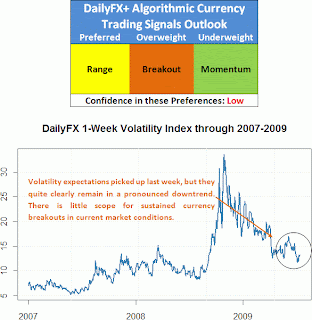Forex markets remain incredibly choppy and major currencies remain in wide ranges. Though volatility expectations crept higher through last week’s trade, we continue to favor Range trading strategies on US Dollar currency pairs. It is nonetheless critical to note that Japanese Yen crosses show great potential for further breakouts, and we will accordingly position ourselves for big JPY moves.
Last week we switched our long-standing Momentum trading bias to favor Range strategies. For the most part this should have worked, but breakouts in Japanese Yen currency pairs clearly would have hurt the profitability of low-volatility strategies. Fortunately for us, our Range2 system uses a forex sentiment-based trend filter to keep us out of trending pairs. We will subsequently leave our Range-trading bias intact, but we feel it's necessary to use caution in taking Range1 or Range2 trades in pairs making extremely sharp intraday moves.

A surge in Japanese Yen volatility expectations gives us a clear Breakout-trading bias in the JPY, and Breakout2 unsurprisingly enjoyed a strong week on impressive Yen strength. We have little reason to believe that volatility will drop substantially in the week ahead, and we will pay close attention to any Breakout2 trades in the safe-haven Yen.
US Dollar volatility expectations are substantially lower, and we will accordingly remain skeptical of any Momentum or Breakout trades in the EURUSD and other major USD pairs. Absent a substantial shift in volatility expectations, it seems that the Greenback could remain rangebound versus the Euro and British Pound.

DailyFX+ Market Conditions Outlook

NOTE: Data has once again been changed. Due to the ineffectiveness of the 30-day horizon, we are returning to the original 90-day time horizon.
Definitions
Volatility Percentile – The higher the number, the more likely we are to see strong movements in price. This number tells us where current implied volatility levels stand in relation to the past 90 days of trading. We have found that implied volatilities tend to remain very high or very low for extended periods of time. As such, it is helpful to know where the current implied volatility level stands in relation to its medium-term range.
Trend – This indicator measures trend intensity by telling us where price stands in relation to its 30 trading-day range. A very low number tells us that price is currently at or near monthly lows, while a higher number tells us that we are near the highs. A value at or near 50 percent tells us that we are at the middle of the currency pair’s monthly range.
Range High – 30-day closing high.
Range Low – 30-day closing low.
Last – Current market price.
Strategy – Based on the above criteria, we assign the more likely profitable strategy for any given currency pair. A highly volatile currency pair (Volatility Percentile very high) suggests that we should look to use Breakout strategies. More moderate volatility levels and strong Trend values make Momentum trades more attractive, while the lowest Vol Percentile and Trend indicator figures make Range Trading the more attractive strategy.
HYPOTHETICAL PERFORMANCE RESULTS HAVE MANY INHERENT LIMITATIONS, SOME OF WHICH ARE DESCRIBED BELOW.
NO REPRESENTATION IS BEING MADE THAT ANY ACCOUNT WILL OR IS LIKELY TO ACHIEVE PROFITS OR LOSSES SIMILAR TO THOSE SHOWN. IN FACT, THERE ARE FREQUENTLY SHARP DIFFERENCES BETWEEN HYPOTHETICAL PERFORMANCE RESULTS AND THE ACTUAL RESULTS SUBSEQUENTLY ACHIEVED BY ANY PARTICULAR TRADING PROGRAM.
ONE OF THE LIMITATIONS OF HYPOTHETICAL PERFORMANCE RESULTS IS THAT THEY ARE GENERALLY PREPARED WITH THE BENEFIT OF HINDSIGHT. IN ADDITION, HYPOTHETICAL TRADING DOES NOT INVOLVE FINANCIAL RISK, AND NO HYPOTHETICAL TRADING RECORD CAN COMPLETELY ACCOUNT FOR THE IMPACT OF FINANCIAL RISK IN ACTUAL TRADING. FOR EXAMPLE, THE ABILITY TO WITHSTAND LOSSES OR TO ADHERE TO A PARTICULAR TRADING PROGRAM IN SPITE OF TRADING LOSSES IS MATERIAL POINTS WHICH CAN ALSO ADVERSELY AFFECT ACTUAL TRADING RESULTS. THERE ARE NUMEROUS OTHER FACTORS RELATED TO THE MARKETS IN GENERAL OR TO THE IMPLEMENTATION.
OF ANY SPECIFIC TRADING PROGRAM WHICH CANNOT BE FULLY ACCOUNTED FOR IN THE PREPARATION OF HYPOTHETICAL PERFORMANCE RESULTS AND ALL OF WHICH CAN ADVERSELY AFFECT ACTUAL TRADING RESULTS. Any opinions, news, research, analyses, prices, or other information contained on this website is provided as general market commentary, and does not constitute investment advice. The FXCM group will not accept liability for any loss or damage, including without limitation to, any loss of profit, which may arise directly or indirectly from use of or reliance contained in the trading signals, or in any accompanying chart analyses.
No comments:
Post a Comment